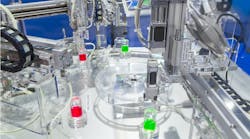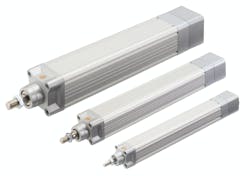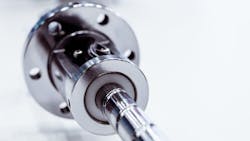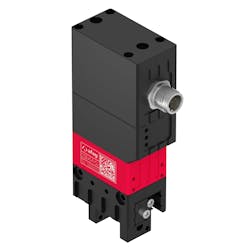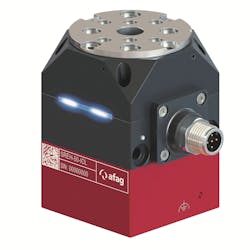Electric linear actuators are valuable and versatile systems that provide fast, efficient and accurate movement of products and materials in today’s high-speed factory automation systems.
Manufacturers offer multiple electric linear actuator models for both single-axis and multi-axis applications. These actuators use a range of designs and motion components to serve different load, accuracy and speed characteristics.
Choosing the right electric linear actuator calls for a deeper understanding of the options available in the industry. With that understanding, original equipment manufacturers (OEMs) and end users can match a selected actuator’s capabilities to the long-term efficiency, productivity and control each machine or production line requires.
Growth of Electric Linear Actuators in Automation
There is steady growth in the use of electric linear actuators in highly automated industries. Electric linear actuators are widely used in automated production platforms with high-speed throughput requirements and repetitive linear motion cycles.
Some heavier industries, such as automotive and tire manufacturers, are in the early stages of adding electric actuators to their production platforms while continuing the use of pneumatic actuators in certain applications and machines.
Automation-intensive segments such as food processing and packaging use a hybrid mix of both pneumatic and electric actuators to drive linear tasks in their machines. In industries such as semiconductor, pharmaceutical and electronics production, electric linear actuators provide very stable and vibration-free linear motion combined with highly accurate and repeatable endpoints, a critical requirement for automated production in these segments.
One main advantage electric linear actuators offer is advanced motion control. Powered by electro-servo drives and motors and connected to production system PLCs, electric linear actuators can provide more agile and flexible control of critical motion factors such as speed, cycle time, endpoint accuracy and repeatability.
In addition, with the built-in power regeneration capabilities common in today’s servo drives, linear actuators can offer automation system designers improved energy efficiency. Smart servo drives combined with sensors embedded in the modules supply crucial real-time data on actuator performance, efficiency and repeatability.
This is critical data manufacturers now routinely require from technology used in their systems to help advance digital transformation in their operations.
READ MORE: Optimizing Linear Motion Solutions Using Hybrid Automation Systems
Assessing Actuator System Design Options
To select the right electric linear actuator, it is helpful for automation system designers to examine and better understand the different kinds of linear actuator technology available in today’s marketplace and the capabilities each option provides.
In general, electric linear actuators can be easily categorized according to their drive mechanics. There are three broad categories of electric linear actuators: belt-driven modules, screw drive or spindle drives and linear motor actuators.
Each has specific speed, load bearing, accuracy and other functional characteristics that guide actuator selection, based on specific manufacturing requirements.
Toothed Belt-Driven Actuators
A belt-driven actuator has an electric drive that powers a toothed rotator at one end of the module. This model converts rotary motion to linear motion by means of a toothed timing belt connected between two pulleys at either end of the drive.
Belt-driven modules work well when the linear sequence calls for medium repeatability, approximately 0.05 mm in motion, although higher repeatability can be supported with the use of integrated direct measuring system sensors.
Typically they can support moving medium-sized loads up to 300 kg. They also work well with larger strokes and sequences requiring a motion velocity greater than 5 m/s. Belt-driven linear modules are widely used in packaging applications to transfer products from one production line to another; they are also used in automated factories producing automotive parts like electric motors.
Leading suppliers offer these systems in a wide range of profile sizes (profile widths) and lengths, making them a modular option for multiple applications. Belt-driven electric actuators are also well-suited for building multi-axis systems such as pick-and-place and Cartesian motion systems.
Spindle or Screw Drive Actuators
In these systems, a spindle or screw in the center of the actuator converts the rotary motion to linear motion to move the load. They provide very high rigidity and low deflection, enabling greater endpoint accuracy with each duty cycle, for applications requiring approximately 0.02 mm repeatability.
These actuators support low to medium dynamics for applications requiring velocities up to 1.5 m/s. Their strength and rigidity also make them highly suited for placement and pressing applications where high force is needed, such as securely inserting an electric component into a larger assembly, such as an electric vehicle battery and material joining. They are also a good choice for vertical applications.
Direct Drive Actuators
In these modules, the belt or spindle is replaced with an electric linear motor that moves the module’s carriage directly, rather than converting rotary to linear motion. They support very high endpoint accuracy, up to 0.01 mm, in part because the force is directly implemented at the moving part (carriage) with no elastic components in between (e.g., the rubber toothed belt).
This direct control also makes very complex start/stop, forward/backward motion sequences possible by programming the linear motor controller. It also supports the broadest range of strokes and velocities up to 10 m/s, as well as very slow and constant movement — which can be a requirement for moving very delicate electronics or other products that are susceptible to damage (e.g., laser applications or printing to achieve a constant result).
Direct drive actuators are often available in very compact sizes, making them a good option for production tools such as semiconductor fabrication systems that need to conserve valuable floor space without sacrificing performance.
READ MORE: Sorting Out Linear Actuators
Guidelines for Optimal Actuator Selection
Every automation machine and production line has unique operational and performance requirements, including the unique specifications for linear motion and transport. Since no two machines are identical, several best practices provide useful criteria automation system designers can use to guide actuator selection.
Automation OEMs and end users should first clearly define what task each actuator must perform in a machine or production line. That requires defining the motion profile for each actuator — and in some complex automated assembly systems, different process steps will call for different actuators with specific capabilities.
A linear actuator motion profile defines key parameters such as load — how much a component or product weighs — as well as the dynamics of the motion: how fast the module accelerates and moves the load with each duty cycle. The moving mass must also be calculated; this includes the material or component being moved, along with the total mass of the actuator, cabling, integrated measuring devices, end grippers and other elements that make up the total load to be moved.
The stroke must also be defined: what is the distance the load must be moved and with what force; this last parameter is especially important if an actuator needs to firmly place or insert a component into a larger assembly. When assessing the force, it is important to factor in the direction of movement: will the actuator be moving product horizontally, vertically or at a certain angle?
Along with these other factors, defining the duty cycle is critical for selecting the most reliable actuator based on the expected long-term performance. For example, there are now modules available with a guaranteed 40 million duty cycles; these data points can help with rapid, high-throughput motion sequences. Within the duty cycle, pause times must also be considered. There is a big difference between actuators that move constantly and actuators that only move during one shift. Additionally, pause time during an individual cycle is important to note. An example of this could be one actuator needing to wait for another axis or process time.
Once defined, the requirement profile gives automation designers the critical criteria for choosing the optimal electric linear actuator for each part of a new machine or assembly line. It is also important to recognize that in some motion applications pneumatic actuators may provide an equally efficient and cost-effective solution.
In addition, electropneumatic hybrid linear actuators can provide a versatile technology that combines the benefits of electric linear actuators and pneumatics. For example, when combining multiple belt-driven linear actuators into a Cartesian handling system for a pick-and-place application, pneumatics may be the most efficient way to actuate the gripper at the end of the Z-axis module in the system.
READ MORE: Pneumatics Help Automate Food Packaging
Working With the Right Actuator Portfolio
Once the requirement profile and linear actuator models are defined, choosing the right supplier is the next critical step.
It’s important to assess the depth and breadth of each supplier’s product lines. Does their portfolio include electric and pneumatic linear actuators, to provide flexible options? Can they provide complete linear solutions that include controllers, cabling, end effector grippers and adaptor plates when needed?
Today’s leading suppliers configure the physical interfaces of their equipment so they can be easily combined together into multi-axis systems when needed. They also offer user-friendly online configuration and ordering tools to help system designers select and configure their modules based on the functional and performance requirements for each linear axis.
When assessing a portfolio, it’s also important to review a company’s ability to innovate. For example, one company recently launched a pioneering compact rotary actuator with the controller integrated into the module. This design saves control cabinet space and improves the motion control capabilities in the system.
Electric linear actuators provide an efficient and versatile tool to help create sophisticated production systems that deliver the performance manufacturers need. The range of electric linear actuator technologies now available gives automation system designers the freedom to choose and configure the right actuator each machine or production line needs.
This article was written and contributed by Linda Schwartzen, product marketing manager for actuators, Emerson, and Niklaus Roethlisberger, product manager for actuators, Emerson, Afag Automation AG.
Editor’s Note: Power & Motion's WISE (Workers in Science and Engineering) hub compiles our coverage of workplace issues affecting the engineering field, in addition to contributions from equity seeking groups and subject matter experts within various subdisciplines.
